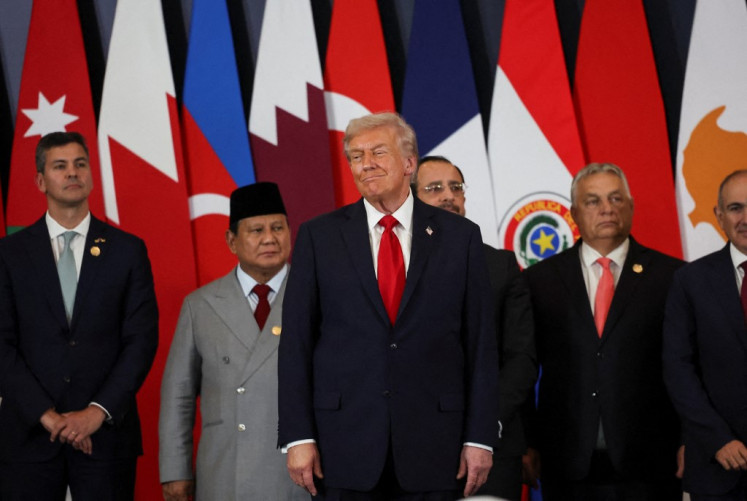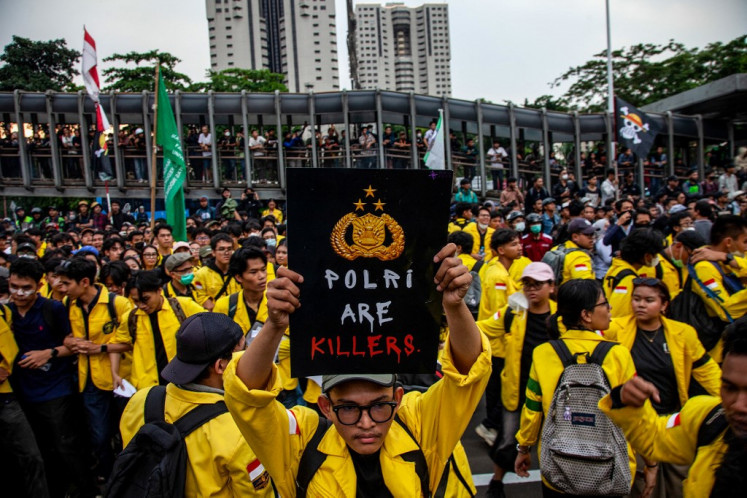Popular Reads
Top Results
Can't find what you're looking for?
View all search resultsPopular Reads
Top Results
Can't find what you're looking for?
View all search resultsCircular economy for plastics: What is at stake for ASEAN?
JP/P
Change text size
Gift Premium Articles
to Anyone
JP/P.J. Leo
The Bangkok Declaration on Combating Marine Debris in ASEAN Region was adopted by leaders of the ASEAN last month, welcoming the ASEAN Framework of Action on Marine Debris. This follows previous commitments made by the leaders on promoting sustainable consumption and production to reduce marine plastic debris.
Why are the leaders suddenly concerned about the use of plastic, despite its multiple economic benefits? The material is cheap, lightweight and easy to make. These qualities have led to a boom in the production of plastic, a petroleum byproduct, for the rapid uptake by industrial and domestic consumers. China is the world’s biggest contributor of plastic waste, responsible for 8.9 million metric tons annually, followed by five Southeast Asian countries, namely Indonesia, the Philippines, Vietnam, Thailand and Malaysia. Collectively, the five countries generate 8.9 million mt of mismanaged plastic waste every year. Indonesia, for instance, contributes 3.22 million mt a year, with half ending up in the seas.
The huge quantity of waste in the oceans is proving fatal to creatures both large and small: sea turtles, dolphins, even whales. And it not just marine life that is being killed by plastics. Birds and land animals are also mistaking synthetic waste material for food, often dying slow, excruciating deaths as a result.
The region’s ability to cope with solid waste in general and plastics in particular is already overwhelmed. Only 9 percent of the 9 billion tons of plastics produced is recycled. If the current consumption and waste management practices continue, by 2050 there will be around 12 billion mt of plastic waste in landfills and oceans. In addition, if the growth in production continues as usual, then the plastic industry may account for 20 percent of the world’s total oil consumption, thus contributing to climate change. The scale of the challenge is daunting, and plastic use has become a full-grown crisis, drawing the attention of ASEAN leaders.
Realizing the severity and the urgency of the problem, earlier this year, countries like Thailand, Indonesia and Malaysia started implementing policy frameworks aimed at introducing a blanket ban of several types of plastics by 2025. The policy road maps coincide with recent efforts by private retailers of products and services who are implementing their own measures to recycle.
These combined efforts have resulted in innovations like the use of plant based and biodegradable polymers as well as improved technologies for recycling plastics and reducing plastic toxicity, thus laying the foundation for a circular economy.
In a circular economy, a scarce resource is used optimally through reuse, repair and recycling. This compares with the wasteful linear extractive system of manufacturing and consumption, in which products are disposed of quickly after use. Three building blocks support the circular economy, namely material and product design, new business models and enabling policy conditions. However, the transition to a circular economy in developing countries of Southeast Asia will be very slow due to many existing barriers unless there are targeted policy interventions.
In a recent Economic Research Institute of ASEAN and East Asia (ERIA) study on the circular economy, it was concluded that businesses in particular are hampered by barriers for increasing resource efficiency through a circular economy approach. These barriers are institutional, organizational, behavioral and market-based, all combining into a web of constraints. A wider range of policy measures are therefore needed at various levels including both changes in the regulatory framework, public spending and consumer engagement.
The circular economy for plastics is not just another environmental policy, it is not just another economic policy, and it is not another trade policy. It is all that and more — requiring a truly cross-sectoral effort, built around peoples’ needs, and should be built together with companies and local governments. A large number of prevailing policies can contribute to circular economy objectives. Existing policies related to waste, resource efficiency, extended producer responsibility, eco-design and green labeling are of high significance as the design and reusable content of the products could trigger changes in the production process that can be beneficial for reuse and remanufacturing of products.
However, a major concern is that these policies can often conflict with each other. For instance, companies that want to use recycled plastic materials in their products may still choose alternate virgin materials because of uncertainties about whether recycled materials will comply with existing standards for ecolabeling.
In addition, waste related rules that aim to control movement of waste in order to avoid illegal exports can have the unintended consequence of making the transport of waste destined for reuse and remanufacturing too expensive.
From 2016 to 2018, Southeast Asia saw plastic waste imports grow by a staggering 171 percent, from 836,529 mt to 2,265,962 mt. This was triggered by China’s announcement in 2017 that it would stop accepting imports of certain classes of waste that come from recycled streams in other parts of the world. This implies that a big part of the policy task for ASEAN in the coming years is to review and address conflicts among existing trade policies on import and demand for primary materials, recycling of secondhand products and harmonization of quality standards.
________________________
Senior economist at the Economic Research Institute for ASEAN and East Asia (ERIA). The views expressed are his own and do not reflect ERIA’s position.
















